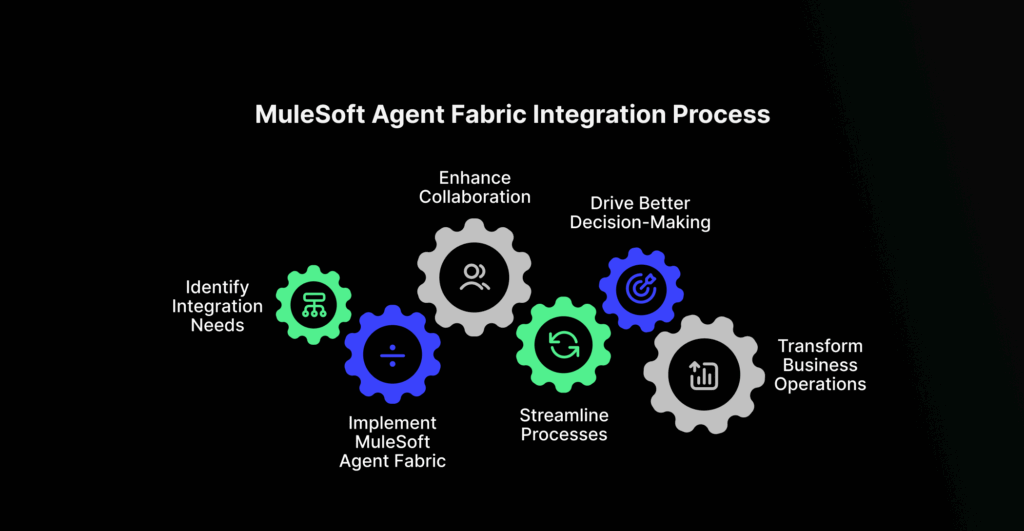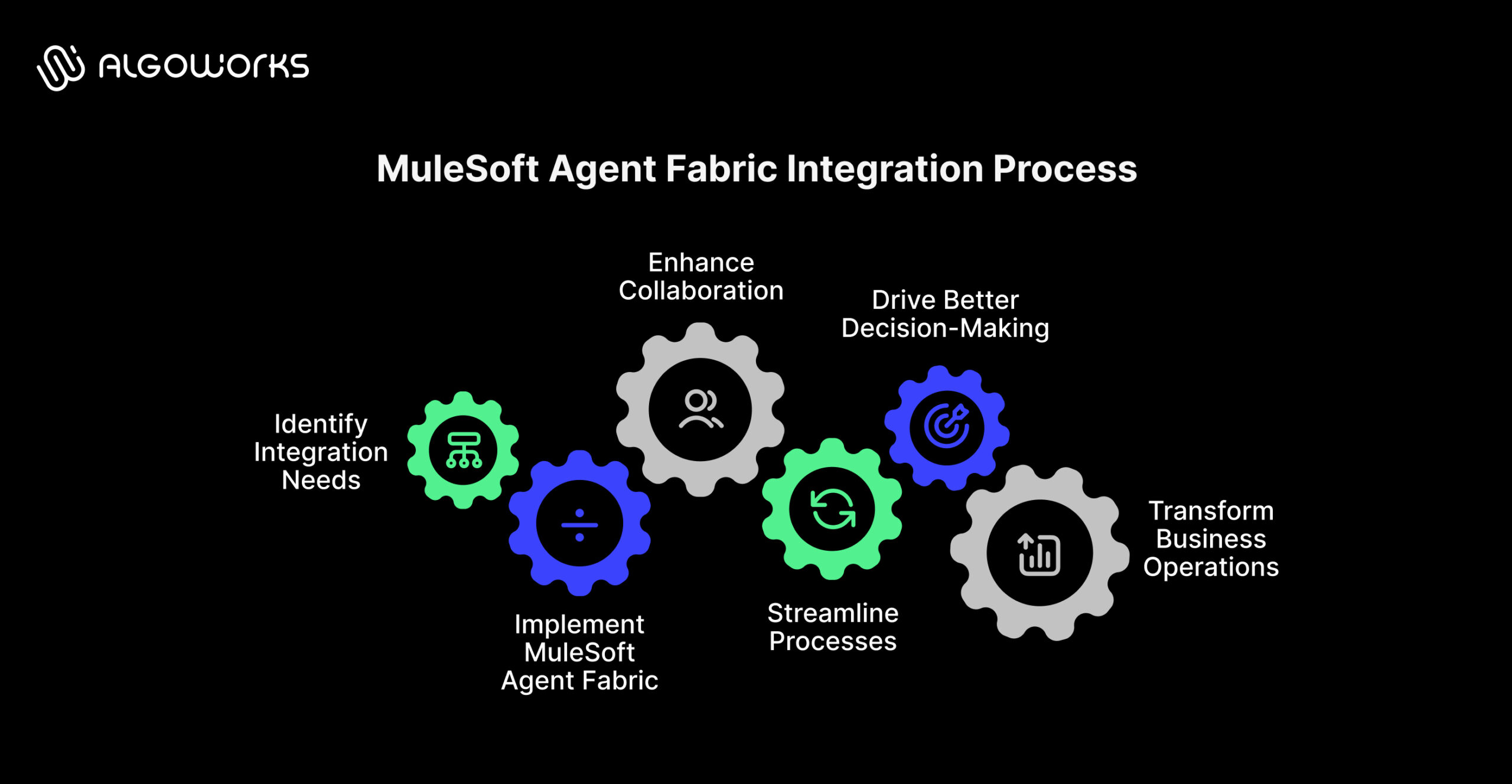Orchestrating AI Agents: How MuleSoft Agent Fabric bridges humans, systems and AI

Companies are rolling out AI agents at record speed; finance uses them to process invoices, marketing for campaigns and customer service to handle tickets. Each agent works well on its own, but most were never designed to collaborate.
As more teams explore AI development services to embed automation across workflows, one problem keeps surfacing: coordination. Without a unified framework, organizations end up managing dozens of disconnected agents that can’t exchange data or context across departments.
That’s agent sprawl and it’s quickly becoming the biggest enterprise IT challenge. MuleSoft Agent Fabric solves it.

The agent sprawl problem
Suppose a customer calls with a complex request. The service agent handles the query but needs credit approval. Credit needs inventory verification. Inventory should check shipping times. Each step becomes a handoff. Each handoff creates a delay.
The impact shows up fast:
- Teams duplicate work across agents
- Compliance blind spots appear
- Security gaps emerge in unmonitored communication
- Customers experience friction from disconnected systems
This challenge is part of a broader AI and digital transformation story; one where orchestration defines success across every layer of the enterprise.
What is MuleSoft Agent Fabric?
MuleSoft Agent Fabric is an enterprise-grade integration layer that connects and manages AI agents across systems, applications and data sources. It provides a standardized way for agents, whether built with Salesforce, OpenAI or other platforms, to discover, communicate and exchange information securely.
In short, it lets organizations coordinate multiple agents as part of a single, connected workflow instead of operating in isolated silos. This concept aligns closely with what is AI in the enterprise sense; intelligent systems that extend human capability, not replace it.
Four core components of MuleSoft Agent Fabric
Agent registry
A directory of every agent and what it does. Teams can find and reuse existing agents. No more rebuilding the same thing five times.
Agent broker
The smart switchboard. When an agent needs help, the broker figures out who to call. It manages conversations and brings in the right resources at the right time.
Agent governance
Your security guard. It monitors every agent’s interaction through Flex Gateway. It applies security policies and keeps sensitive data protected. This matters when agents touch customer information or make regulated decisions, reinforcing the need for AI literacy within enterprise teams.
Agent visualizer
Your control tower. See what’s happening in real-time. Trace how agents collaborate. Spot bottlenecks before they explode. Catch problems early.
How is this different from regular integration?
Traditional integration is built around predictability. APIs work in a request-response pattern; you send input A, you get output B. It’s structured, deterministic and rule-based.
AI agents, on the other hand, operate very differently. They don’t just execute commands; they interpret intent, hold context, and make probabilistic decisions. They might need data from multiple systems at once and must continuously adapt as conversations evolve.
MuleSoft Agent Fabric bridges this gap. It takes MuleSoft integration services; API management, governance and connectivity, and extends it to support dynamic, bidirectional communication between agents and systems. It brings order and reliability to an environment where context and uncertainty define how work gets done.
Three critical bridges
To understand how MuleSoft Agent Fabric actually works, it helps to see what it connects. The platform isn’t just about linking data; it’s about bridging people, systems, and AI so they operate as one cohesive network. Here’s how those bridges come together.
Bridge 1: Connecting humans and AI
Human oversight is essential. Even advanced agents need structured governance. MuleSoft Agent Fabric enables smart escalation paths; routine decisions flow automatically, while exceptions go to the right reviewer.
For instance, in credit approvals, the agent clears standard cases but flags unusual spending or missing data for human review. The Agent Visualizer adds transparency to all this. It shows how the AI reached its decision, what data it used, and where human review was applied. That visibility is crucial for compliance-heavy industries: finance, healthcare, government, where accountability isn’t optional but mandatory.
Bridge 2: Connecting AI to systems
Agents depend on diverse data: legacy systems, SaaS apps and external APIs. MuleSoft Agent Fabric, powered by Salesforce integration services, gives agents secure, real-time access without creating point-to-point chaos.
In healthcare, a care coordination agent might:
- Check patient records in one system
- Verify insurance in another
- Schedule appointments
- Sync with pharmacy data
Instead of juggling connections, the agent makes one request; the platform handles orchestration, security and delivery.
The governance layer enforces access control, validates each request and logs every exchange. Setting this up correctly takes skill, which is why many organizations partner with MuleSoft consulting experts to configure these policies and guardrails from the start.
Bridge 3: Connecting AI to AI
Things get really interesting at this stage. Unlike systems that just exchange static data, agents engage in contextual conversations. One agent can request information, receive a partial answer, clarify details and refine its query in multiple rounds.
MuleSoft Agent Fabric supports this kind of dynamic exchange using the Model Context Protocol (MCP). The Agent Broker acts as a central router, ensuring every message finds its correct recipient and carries the proper context.
Now imagine the opposite: one agent “hallucinates” or produces inaccurate data, another accepts it as fact, and a third makes business decisions based on it. That’s how cascading errors spread.
MuleSoft Agent Fabric mitigates risk through built-in monitoring and tracing. It observes every message flow, flags inconsistencies, and isolates bad data before it reaches end users or customers. Essentially, it prevents a small agent mistake from snowballing into a major business issue.
The broader impact: Why orchestration defines the next phase of AI adoption
What’s happening right now across enterprises looks a lot like the early days of cloud adoption. Every department is experimenting with AI agents, building them fast, deploying faster; but without a shared framework. That’s how the same patterns of fragmentation and redundancy start repeating.
MuleSoft Agent Fabric changes that trajectory. Instead of layering more agents onto disjointed systems, it establishes a connected foundation for how those agents operate: securely, transparently, and in alignment with existing enterprise governance. The goal isn’t to add more automation. It’s to create coordinated intelligence across every layer of the business.
When finance, operations, and customer experience share the same orchestration backbone, insights compound. Agents stop acting like separate chatbots and start behaving like extensions of a unified enterprise brain.
This shift echoes emerging Agentic AI trends that redefine how enterprise systems collaborate, learn, and reason across distributed environments.
What this means for IT leaders
CIOs and CTOs are under pressure to bring order to AI adoption; without slowing innovation. MuleSoft Agent Fabric gives them the control they need to standardize agent-to-agent and agent-to-system communication while letting teams experiment freely.
The benefit is twofold:
- Centralized governance, decentralized innovation. Teams can build domain-specific agents with support from a MuleSoft development company, but they all plug into the same orchestration layer.
- Future-proof architecture. Whether it’s new models, new vendors, or new compliance requirements, the integration layer remains stable.
This structure mirrors how successful enterprises handled the API boom. Those that built consistent integration strategies early went on to scale faster, with fewer operational failures and stronger compliance postures. Agent orchestration will follow the same curve.
The bottom line
From a business perspective, orchestration delivers something far more valuable than technology alignment; it delivers clarity. By late 2025 and into 2026, agent orchestration platforms like MuleSoft Agent Fabric will become standard infrastructure; just like APIs, CI/CD pipelines, or data lakes.
The enterprises that move early will avoid the cost of rebuilding later when their agents start clashing or duplicating work. Will you orchestrate it intentionally? Or manage the chaos reactively? The choice is yours.
To explore how MuleSoft Agent Fabric can transform your AI ecosystem, visit www.algoworks.com or reach out to our MuleSoft consulting experts today.
FAQs
What is MuleSoft Agent Fabric?
It’s an integration layer that connects and manages AI agents across systems, ensuring secure and coordinated workflows.
How is it different from traditional integration?
Traditional integrations are rule-based and linear; Agent Fabric supports dynamic, context-aware communication between agents and systems.
What problem does it solve?
It tackles agent sprawl by connecting disconnected agents, reducing duplication, and maintaining governance and data consistency.
Does it work only with Salesforce?
No. It’s platform-agnostic and can connect agents built on Salesforce, OpenAI, or any other AI framework.
How can businesses get started?
Begin by assessing current AI workflows and partner with MuleSoft consulting experts to set up governance and orchestration.

